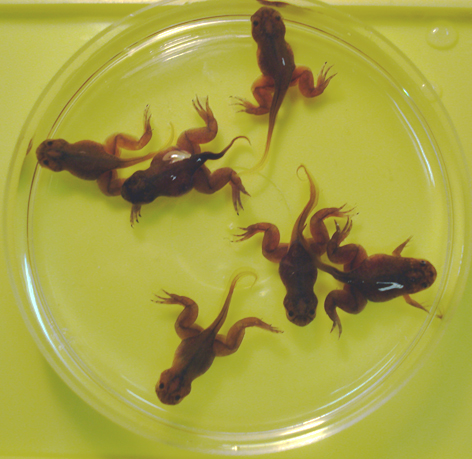A Farewell to (frog) Arms (apologies to Hemingway)
Posted by Anita Abu-Daya, on 15 December 2010
The backstory to our recent Developmental Biology paper “The secreted integrin ligand nephronectin is necessary for forelimb formation in Xenopus tropicalis” includes scenes of several members of the Zimmerman lab peering at a tank of metamorphosing transgenic frogs, scratching their heads, and agreeing that some of them “looked funny” (the frogs, not the researchers) before realizing that while their hindlimbs had formed normally, their forelimbs were completely absent.

In winter of 2005, I had been working for some time in Lyle Zimmerman’s lab at the NIMR, London, bringing genetic analysis to the study of amphibian developmental biology. Xenopus tropicalis, unlike the closely related allo-tetraploid Xenopus laevis, is a true diploid, with one of the smallest tetrapod genomes, and is amenable to genetic analysis. By the end of 2005, we had finished a pilot screen to identify chemically induced mutations affecting X. tropicalis early development. However, one of the most striking mutants appeared not in the ENU screen, but while feeding a tank of tadpoles from a transgenic line that we were breeding to homozygosity for an unrelated project. As the tadpoles began metamorphosing into froglets about 25% of them developed without arms (see attached picture, courtesy T. Geach), and it became increasingly likely that we were looking at the result of a serendipitous transgene insertion disrupting a locus that was necessary for forelimb development. The effect of the insertional mutation appeared to be very specific, no other developmental defects were evident.
I was able to fairly rapidly clone the site of insertion in the nephronectin (npnt) gene, which had been recently identified in Louis Reichardt’s lab as a ligand for a8b1 integrin, necessary for metanephros development in mouse. Thus the xenopus de milo (xdm) mutant suggests a novel role for integrin signalling in limb development. We are lucky to work in a large, interdisciplinary institute, in the same division as Malcolm Logan, an expert on limb type specification and patterning, and a collaboration was quickly set up with Satoko Nashimoto, a postdoc in the Logan lab. Working together we were able to show that xmd homozygotes did not express tbx5, the earliest marker of the emerging forelimb, in the forelimb field, never developed forelimb buds, and that all elements of the forelimb skeleton were absent in xdm froglets, consistent with a role for npnt in forelimb initiation.
Amphibian limb regeneration has been extensively studied but little is known about limb initiation in Xenopus. Frogs develop arms after several weeks as free-swimming tadpoles, as opposed to other vertebrates in which limbs form in parallel with other organ systems relatively early in embryogenesis. There is some evidence that the specific lineages and signalling pathways necessary for limb initiation in Xenopus are different from those in chick or mouse. Significantly the mouse npnt knockout does not have a forelimb phenotype. It remains to be determined whether integrin signalling is necessary for forelimbs uniquely in frogs, or whether it plays a more general role, but is mediated through other ligands in mammals. Understanding how the metamorphosing tadpole initiates limbs that are highly homologous to those of other vertebrates will help us understand processes critical for vertebrate limb formation and regeneration.


 (14 votes)
(14 votes)
This is probably hugely inappropriate but the mutant frogs kind of reminded me of a theory put out there by the Far Side comics
http://blogs.discovermagazine.com/intersection/files/2009/04/sperm-cartoon.jpg